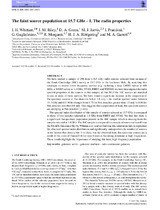| dc.contributor.author | Whittam, I. | |
| dc.contributor.author | Riley, J. | |
| dc.contributor.author | Jarvis, Matt | |
| dc.contributor.author | Green, D.A. | |
| dc.contributor.author | Prandoni, I. | |
| dc.contributor.author | Guglielmino, G. | |
| dc.contributor.author | Morganti, R. | |
| dc.contributor.author | Röttgering, H. J. A. | |
| dc.contributor.author | Garrett, M. A. | |
| dc.date.accessioned | 2017-07-24T07:10:40Z | |
| dc.date.available | 2017-07-24T07:10:40Z | |
| dc.date.issued | 2013 | |
| dc.identifier.citation | Whittam, I. et al. (2013). The faint source population at 15.7 GHz - I. The radio properties. Monthly Notices of the Royal Astronomical Society, 429: 2080–2097 | en_US |
| dc.identifier.issn | 0035-8711 | |
| dc.identifier.uri | http://hdl.handle.net/10566/3094 | |
| dc.identifier.uri | http://dx.doi.org/10.1093/mnras/sts478 | |
| dc.description.abstract | We have studied a sample of 296 faint (>0.5 mJy) radio sources selected from an area of
the Tenth Cambridge (10C) survey at 15.7 GHz in the Lockman Hole. By matching this
catalogue to several lower frequency surveys (e.g. including a deep GMRT survey at 610
MHz, aWSRT survey at 1.4 GHz, NVSS, FIRST and WENSS) we have investigated the radio
spectral properties of the sources in this sample; all but 30 of the 10C sources are matched
to one or more of these surveys. We have found a significant increase in the proportion of
flat-spectrum sources at flux densities below ≈1 mJy – the median spectral index between
15.7 GHz and 610 MHz changes from 0.75 for flux densities greater than 1.5 mJy to 0.08 for
flux densities less than 0.8 mJy. This suggests that a population of faint, flat-spectrum sources
are emerging at flux densities 1mJy.
The spectral index distribution of this sample of sources selected at 15.7 GHz is compared
to those of two samples selected at 1.4 GHz from FIRST and NVSS. We find that there is
a significant flat-spectrum population present in the 10C sample which is missing from the
samples selected at 1.4 GHz. The 10C sample is compared to a sample of sources selected from
the SKADS Simulated Sky byWilman et al. and we find that this simulation fails to reproduce
the observed spectral index distribution and significantly underpredicts the number of sources
in the faintest flux density bin. It is likely that the observed faint, flat-spectrum sources are a
result of the cores of Fanaroff–Riley type I sources becoming dominant at high frequencies.
These results highlight the importance of studying this faint, high-frequency population. | en_US |
| dc.language.iso | en | en_US |
| dc.publisher | Oxford University Press | en_US |
| dc.rights | Copyright the Authors. Authors may archive the published version in their institutional repository. | |
| dc.source.uri | http://dx.doi.org/10.1093/mnras/sts478 | |
| dc.subject | Galaxies: active | en_US |
| dc.subject | Galaxies: starburst | en_US |
| dc.subject | Radio continuum: galaxies | en_US |
| dc.title | The faint source population at 15.7 GHz - I. The radio properties | en_US |
| dc.type | Article | en_US |
| dc.description.accreditation | Web of Science | |

